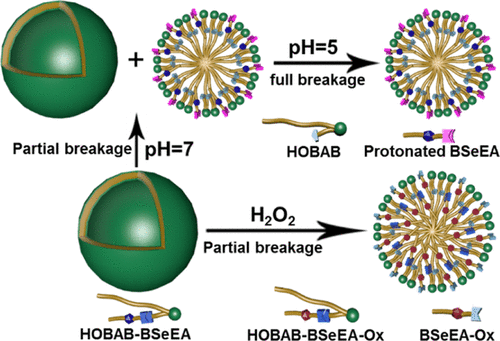Our official English website, www.x-mol.net, welcomes your
feedback! (Note: you will need to create a separate account there.)
Oxidation-Induced Breakage of the Imine Bond and Aggregate Transition in a Se-Containing Dynamic Covalent Surfactant
Langmuir ( IF 3.7 ) Pub Date : 2021-02-21 , DOI: 10.1021/acs.langmuir.0c03609 Pingping Lu 1 , Shuai He 2 , Yue Zhou 1 , Yongmin Zhang 1
Langmuir ( IF 3.7 ) Pub Date : 2021-02-21 , DOI: 10.1021/acs.langmuir.0c03609 Pingping Lu 1 , Shuai He 2 , Yue Zhou 1 , Yongmin Zhang 1
Affiliation

|
Controlling the dynamic imine bonds upon a novel trigger except for pH and temperature is still a significant challenge. Here, a Se-containing imine-based dynamic covalent surfactant (HOBAB–BSeEA) was developed for the first time by mixing two precursors in situ: an asymmetric double-chain cationic surfactant bearing a formyl group at the terminal of one hydrophobic tail and a Se-containing amine (2-(benzylselanyl)ethan-1-amine) in order to confirm the effect of redox on the imine bonds. The imine bond in HOBAB–BSeEA can be regulated not only upon changing the pH as well as other common imine-based surfactants but also by oxidation. The conversion efficiency of imine bonds is closely related with the degree of oxidation and pH. Complete oxidation can decrease the conversion efficiency from ∼87 to 48%, which is comparable to the result of changing the pH from 10.0 to 7.0. With the formation and breaking of imine bonds, the surfactant can be reversibly switched between symmetric and asymmetric structures, accompanied by a morphological transition from vesicles to spherical micelles. Although oxidation cannot demolish all imine bonds, it can completely convert vesicles to spherical micelles, which is mainly ascribed to an increase in the polarity of the micellar microenvironment stemming from the oxidation of Se. However, this transition can only be achieved by reducing the pH to 5.0 instead of 7.0. Nile red loaded in HOBAB–BSeEA vesicles can be quickly, controllably, and step-by-step released upon oxidation stimulus but not pH. Understanding the mechanism of oxidation-induced breakage of imine bonds and disruption of vesicles would be useful in designing redox-responsive imine-based carriers that can unload cargoes according to the level of the local reactive oxygen species.
中文翻译:

含硒动态共价表面活性剂中亚胺键的氧化诱导断裂和聚集跃迁
除了pH和温度以外,在新型触发条件下控制动态亚胺键仍然是一项重大挑战。在这里,通过将两种前体原位混合,首次开发了一种含硒的基于亚胺的动态共价表面活性剂(HOBAB–BSeEA):一种不对称的双链阳离子表面活性剂,其在一个疏水尾部的末端带有甲酰基。为了证实氧化还原对亚胺键的影响,含硒的胺(2-(苄基亚硒基)乙-1-胺)。HOBAB–BSeEA中的亚胺键不仅可以通过改变pH值以及其他常见的基于亚胺的表面活性剂来调节,还可以通过氧化来调节。亚胺键的转化效率与氧化程度和pH值密切相关。完全氧化可将转化效率从约87%降低至48%,这相当于将pH从10.0更改为7.0的结果。随着亚胺键的形成和断裂,表面活性剂可以在对称和不对称结构之间可逆地转换,并伴随着从囊泡到球形胶束的形态转变。尽管氧化不能消除所有的亚胺键,但它可以将囊泡完全转化为球形胶束,这主要归因于Se氧化引起的胶束微环境极性的增加。但是,只能通过将pH值降低到5.0而不是7.0来实现这种转变。负载在HOBAB-BSeEA囊泡中的尼罗红可以快速,可控地通过氧化刺激逐步释放,但不能通过pH释放。
更新日期:2021-03-02
中文翻译:

含硒动态共价表面活性剂中亚胺键的氧化诱导断裂和聚集跃迁
除了pH和温度以外,在新型触发条件下控制动态亚胺键仍然是一项重大挑战。在这里,通过将两种前体原位混合,首次开发了一种含硒的基于亚胺的动态共价表面活性剂(HOBAB–BSeEA):一种不对称的双链阳离子表面活性剂,其在一个疏水尾部的末端带有甲酰基。为了证实氧化还原对亚胺键的影响,含硒的胺(2-(苄基亚硒基)乙-1-胺)。HOBAB–BSeEA中的亚胺键不仅可以通过改变pH值以及其他常见的基于亚胺的表面活性剂来调节,还可以通过氧化来调节。亚胺键的转化效率与氧化程度和pH值密切相关。完全氧化可将转化效率从约87%降低至48%,这相当于将pH从10.0更改为7.0的结果。随着亚胺键的形成和断裂,表面活性剂可以在对称和不对称结构之间可逆地转换,并伴随着从囊泡到球形胶束的形态转变。尽管氧化不能消除所有的亚胺键,但它可以将囊泡完全转化为球形胶束,这主要归因于Se氧化引起的胶束微环境极性的增加。但是,只能通过将pH值降低到5.0而不是7.0来实现这种转变。负载在HOBAB-BSeEA囊泡中的尼罗红可以快速,可控地通过氧化刺激逐步释放,但不能通过pH释放。











































 京公网安备 11010802027423号
京公网安备 11010802027423号